
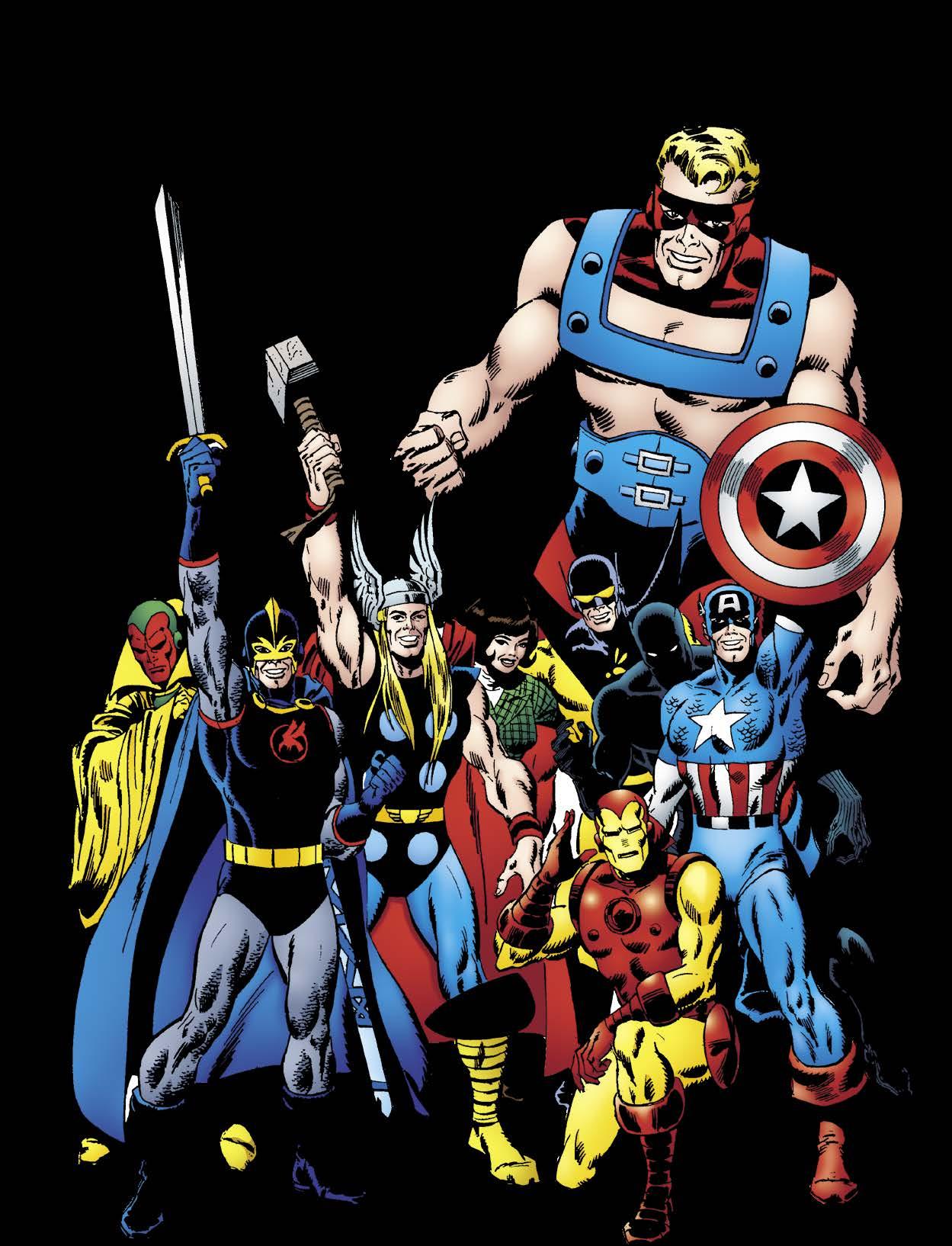
July 2024
MARVELS’ 30TH ANNIVERSARY with KURT BUSIEK & ALEX ROSS Marvelmania International • Marvel Novel Series • Marvel Value Stamps • Marvel Classics Marvel Age Magazine • FABIAN NICIEZA Captain America interview & more
No.152
$10.95
MARVELMANIA ISSUE featuring THE AVENGERS by SAL BUSCEMA
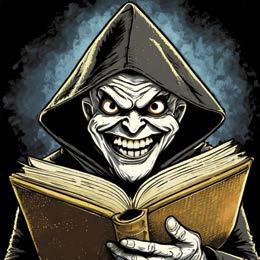
“Greetings, creep culturists! For my debut issue, I, the CRYPTOLOGIST (with the help of FROM THE TOMB editor PETER NORMANTON), have exhumed the worst Horror Comics excesses of the 1950s, Killer “B” movies to die for, and the creepiest, kookiest toys that crossed your boney little fingers as a child! But wait... do you dare enter the House of Usher, or choose sides in the skirmish between the Addams Family and The Munsters?! Can you stand to gaze at Warren magazine frontispieces by this issue’s cover artist BERNIE WRIGHTSON, or spend some Hammer Time with that studio’s most frightening films? And if Atlas pre-Code covers or terrifying science-fiction are more than you can take, stay away! All this, and more, is lurching toward you in TwoMorrows Publishing’s latest, and most decrepit, magazine—just for retro horror fans, and featuring my henchmen WILL MURRAY, MARK VOGER, BARRY FORSHAW, TIM LEESE, PETE VON SHOLLY, and STEVE and MICHAEL KRONENBERG!”
(84-page FULL-COLOR magazine) $10.95 (Digital Edition) $4.99
#1 ships October 2024!

CRYPTOLOGY #2
The Cryptologist and his ghastly little band have cooked up more grisly morsels, including: ROGER HILL’s conversation with our diabolical cover artist DON HECK, severed hand films, pre-Code comic book terrors, the otherworldly horrors of Hammer’s Quatermass, another Killer “B” movie classic, plus spooky old radio shows, and the horror-inspired covers of the Shadow’s own comic book. Start the ghoul-year with retro-horror done right by FORSHAW, the KRONENBERGS, LEESE, RICHARD HAND, VON SHOLLY, and editor PETER NORMANTON
(84-page FULL-COLOR magazine) $10.95
(Digital Edition) $4.99 • Ships January 2025
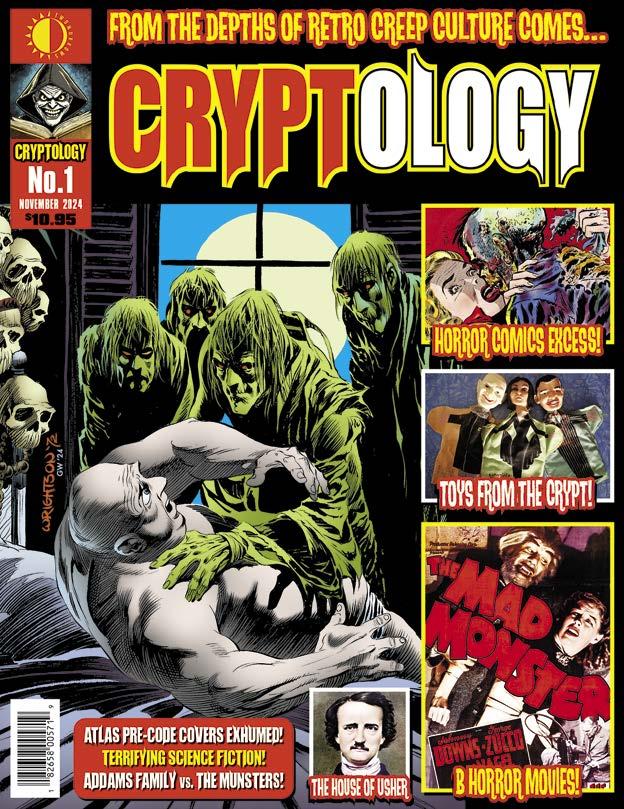

CRYPTOLOGY #3
This third wretched issue inflicts the dread of MARS ATTACKS upon you—the banned cards, the model kits, the despicable comics, and a few words from the film’s deranged storyboard artist PETE VON SHOLLY! The chilling poster art of REYNOLD BROWN gets brought up from the Cryptologist’s vault, along with a host of terrifying puppets from film, and more comic books they’d prefer you forget! Plus, more Hammer Time, JUSTIN MARRIOT on obscure ’70s fear-filled paperbacks, another Killer “B” film, and more to satiate your sinister side!
(84-page FULL-COLOR magazine) $10.95
(Digital Edition) $4.99 • Ships April 2025

CRYPTOLOGY #4
Our fourth putrid tome treats you to ALEX ROSS’ gory lowdown on his Universal Monsters paintings! Hammer Time brings you face-to-face with the “Brides of Dracula”, and the Cryptologist resurrects 3-D horror movies and comics of the 1950s! Learn the origins of slasher films, and chill to the pre-Code artwork of Atlas’ BILL EVERETT and ACG’s 3-D maestro HARRY LAZARUS. Plus, another Killer “B” movie and more awaits retro horror fans, by NORMANTON, the KRONENBERGS, LEESE, VOGER, and VON SHOLLY!
Ships
(84-page FULL-COLOR magazine) $10.95 (Digital Edition) $4.99 •
July 2025
All characters and properties TM & © their respective owners.
TwoMorrows. The Future of Comics History. TwoMorrows Publishing 10407 Bedfordtown Drive Raleigh, NC 27614 USA 919-449-0344 E-mail: store@twomorrows.com Order at twomorrows.com Horror Four-issue subscriptions: $53 in the US $78 International $19 Digital Only
Satiate Your Sinister Side!
EDITOR-IN-CHIEF
Michael Eury
PUBLISHER
John Morrow
DESIGNER
Rich Fowlks
COVER ARTIST
Sal Buscema
(Art originally appeared as the cover for Marvemania Catalog #2, 1970. Scan courtesy of Heritage Auctions.)
COVER COLORIST
Glenn Whitmore
COVER DESIGNER
Michael Kronenberg
PROOFREADER
Kevin Sharp
SPECIAL THANKS
Jim Amash
Tom Brevoort
Sal Buscema
Kurt Busiek
Shaun Clancy
Edinburgh Comic Con
Chris Eliopoulous
Mark Evanier
Irving Forbush
Karl Heitmueller, Jr.
Fred Hembeck
Heritage Auctions
Dan Johnson
Douglas R. Kelly
Richard Kelsey
Scott Kress, Catskill Comics
Paul Kupperberg
James Lundy
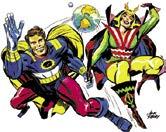

BACKSEAT DRIVER: Editorial by Michael Eury

Number 152
2024
Volume 1,
July
THE RIGHT THING! A
&
to
ILLEGAL
!
only
through our Apple and Google Apps!
DON’T SHARE THEM WITH FRIENDS OR POST THEM ONLINE. Help us keep producing great publications like this one!
STEAL our
C’mon citizen, DO
Mom
Pop publisher like us needs every sale just
survive! DON’T DOWNLOAD OR READ
COPIES ONLINE
Buy affordable, legal downloads
at www.twomorrows.com or
&
Don’t
Digital Editions!
. . . . . . . . . . . . . . . 2 Notes on this
plus the infamous
International fan club
7 A
the
artist proved a blessing for fans OFF MY CHEST: Marvel Novel Series . . . . . . . . . . . . . . . . . . . . . . . . . . . . . . . . . . . . . . 18 Paul Kupperberg recalls the challenges of adapting superheroes to prose FLASHBACK: Marvel Value Stamps . . . . . . . . . . . . . . . . . . . . . . . . . . . . . . . . . . . . . . . 23 The popular mid-1970s initiative that drove readers to cut up their comic books PRINCE STREET NEWS: Lost Marvel Merchandise of the Bronze Age 29 Go on a supermarket sweep with cartoonist Karl Heitmueller, Jr. BEYOND CAPES: Marvel Classics Comics . . . . . . . . . . . . . . . . . . . . . . . . . . . . . . . . . . 31 Step aside, CliffsNotes, as Mighty Marvel adapts literature’s best FLASHBACK: Marvel Age . . . . . . . . . . . . . . . . . . . . . . . . . . . . . . . . . . . . . . . . . . . . . . . . 43 Jim Salicrup and pals revisit the House of Ideas’ ’80s Marvel zine INTERVIEW: Fabian Nicieza and The Adventures of Captain America 51 An in-depth chat with the writer of the inspirational retelling of Cap’s early years GREATEST STORIES NEVER TOLD: Tales from Earth-U(slan) . . . . . . . . . . . . . . . . . . . 63 Batman movie producer Michael Uslan had big plans for the Marvel Universe PRO2PRO: Kurt Busiek and Alex Ross . . . . . . . . . . . . . . . . . . . . . . . . . . . . . . . . . . . . . 68 The superstar duo revisits Marvels on its 30th anniversary BACK TALK: Reader Reactions . . . . . . . . . . . . . . . . . . . . . . . . . . . . . . . . . . . . . . . . . . . 76 BACK ISSUE™ issue 152, July 2024 (ISSN 1932-6904) is published monthly (except Jan., March, May, and Nov.) by TwoMorrows Publishing, 10407 Bedfordtown Drive, Raleigh, NC 27614, USA. Phone: (919) 4490344. Periodicals postage paid at Raleigh, NC. POSTMASTER: Send address changes to Back Issue, c/o TwoMorrows, 10407 Bedfordtown Drive, Raleigh, NC 27614. Michael Eury, Editor-in-Chief. John Morrow, Publisher. Editorial Office: BACK ISSUE, c/o Michael Eury, Editor-in-Chief, 112 Fairmount Way, New Bern, NC 28562. Email: euryman@gmail.com. Eight-issue subscriptions: $97 Economy US, $147 International, $39 Digital. Please send subscription orders and funds to TwoMorrows, NOT to the editorial office. Cover artwork by Sal Buscema. The Avengers TM & © Marvel. All Rights Reserved. All editorial matter © 2024 TwoMorrows and Michael Eury, except Prince Street News © 2024 Karl Heitmueller, Jr. Printed in China. FIRST PRINTING Comics’ Bronze Age and Beyond! Marvelmania Issue • BACK ISSUE • 1 TM & © Marvel.
Lute
Macchio
Maguire
Mangels
Comics
Menzies
Millsted
Moench
Nicieza
NolenWeathington
Salicrup
Speelman
Thomas
Turnbull
Wolfman
Jon Zimmerman
. . . . . . . . . . . . . . . . .
issue,
Marvelmania
BACKSTAGE PASS: Sal Buscema and Earth’s Mightiest Heroes
“nightmare” assignment for
superstar
Ed
Ralph
Kevin
Andy
Marvel
Robert
Ian
Doug
Fabian
Eric
Jim
Tom
Roy
Gerry
Marv
Dwight
by Michael Eury
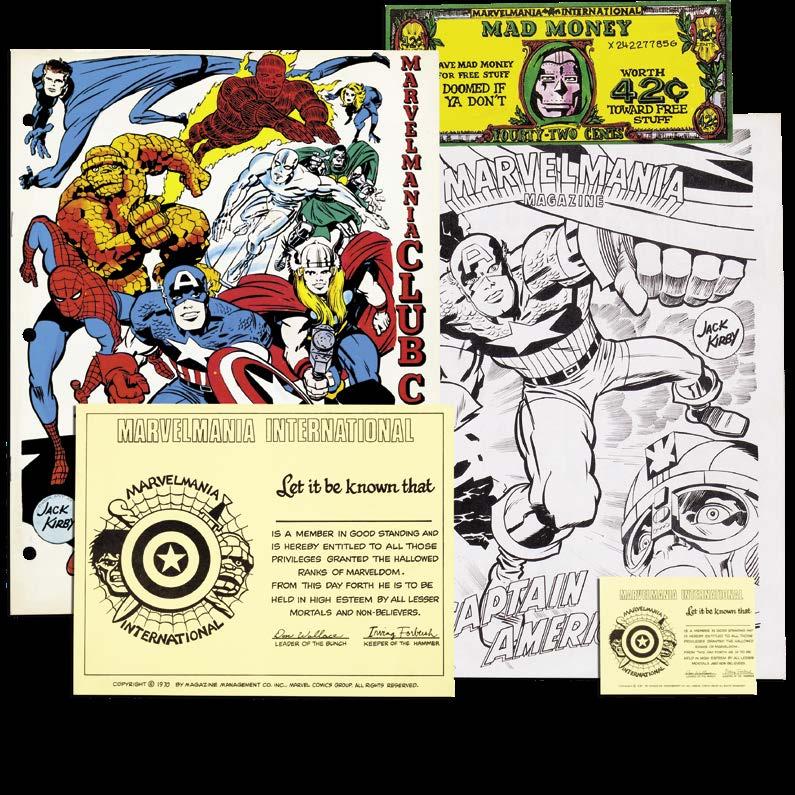
You don’t have to be a Marvel Zombie to catch Marvelmania. Sure, the M.M.M.S. membership card–carrying True Believer is most susceptible to this highly contagious condition. But Marvelmania does not discriminate. You might be devoutly devouring your favorite title from the Distinguished Competition or a cutting-edge creator-owned series when something special from the House of Ideas crosses your path. Too late! You’ve been infected with Marvelmania! There’s no vaccine to protect you against it and no cure for the condition outside of a Marvel comic fix. Or an edition of BACK ISSUE devoted to Marvel material from the Bronze Age and Copper Age.
You can thank occasional BI contributor Robert Menzies for this issue’s theme, although Robert himself may be surprised to read this. Some five years ago, Robert offered to BACK ISSUE his 2018 interview with Fabian Nicieza about the 1991 Adventures of Captain America limited series Fabian wrote and Kevin Maguire drew (well, Kevin drew most of it… and knocked each and every panel right outta the park!). Initially I had intended to schedule it in the first appropriately themed issue and placed it aside… but issues zipped past, as did years, with the interview collecting cyber-dust on my hard drive.
Last year, after scheduling back-to-back DC Comics covers for BI #150 (Batman) and #151 (Sandman and Death), it was time to balance our coverage between publishers by running a Marvel Comics cover for issue #152. At last—a home for the Fabian Nicieza Captain America interview! Then I received an email from Marvel artist Don Hudson reminding me that 2024 marks the 30th Anniversary of Marvels, so a Pro2Pro interview reuniting that series’ writer Kurt Busiek and artist Alex Ross was added to the issue. And coincidentally, at that time my former DC Comics colleague Paul Kupperberg shared with me his article about his Marvel Novel Series offerings. In addition to the Marvel material that literally fell into my editorial lap, this Marvel-themed issue allows BI the chance to finally spotlight Marvel Value Stamps, Marvel Classics Series, and the ’80s fanzine Marvel Age. There’s also
a Greatest Stories Never Told about Michael Uslan’s unrealized Marvel series—from what we affectionately call Earth-U(slan)— that had been under discussion since we ran a similar DC-themed Earth-U piece a while back, and a Prince Street News cartoon prepared by Karl Heitmueller, Jr., specifically for this issue.
Of course, either a Maguire Captain America or Ross Marvels cover for BACK ISSUE #152 would’ve been dynamite (although I’d hate to have had to choose between the two). Heck, a Bob Larkin Spider-Man vs. Hulk Marvel Novel painted cover would’ve been a blast, too!
With the deepest respect to those superb talents (each of whom has graced BI ’s cover spot at least once), there is one Mighty Marvel artist whose work we have yet to cover-feature… until now. He has frequently been cited in our interior pages (not surprising for one of the Bronze Age’s most prolific illustrators) and has often chimed in with answers to interviewers’ questions, but in the 20-plus years we’ve been publishing this magazine, this is the first opportunity we’ve had to showcase on our cover the artwork of the amazing Sal Buscema! Once ye ed stumbled across Mr. Buscema’s iconic Avengers cover for Marvelmania Catalog #2 (1970), I knew I’d found the perfect piece for this edition’s BACK ISSUE cover. We’d hoped to interview Sal Buscema for this issue, but sadly he was unavailable. So the intrepid Robert Menzies (this issue’s undisputed Fearless Front Facer) rallied to the rescue by presenting an incisive study of exploring Sal’s contributions to Earth’s Mightiest Heroes.
The Buscema Avengers cover art this issue is no doubt familiar to many of you, and you may have seen characters excerpted from it for different Marvel merchandise. Prior to rendering this cover—perhaps the most perfect “money shot” Avengers depiction anyone could imagine—Sal penciled a similarly staged group portrait of the team (inked by Sam Grainger) at the end of The Avengers #71 (Dec. 1969).
While we prepare to delve into the Marvelmania that awaits in the pages that follow, let’s not forget that “Marvelmania
2 • BACK ISSUE • Marvelmania Issue
Marvelmania membership materials from the fan club’s first two years.
TM & © Marvel.
International” is also the name of a brief and rather infamous initiative in Marvel Comics’ history. And who better to explain this to BI than one of Marvel Comics’ top editors, Tom Brevoort? On The Tom Brevoort Experience (www.tombrevoort.com), Tom blogged, “Marvelmania was a short-lived operation set up in 1969 to sell licensed merchandise of Marvel characters. It was positioned in the books as a spiritual successor to the Merry Marvel Marching Society, Marvel’s in-house fan club, but in fact it was a separate fly-by-night organization entirely, one set up and licensed by Don Wallace. According to [comics and television writer] Mark Evanier, who worked for Marvelmania for a time, Wallace didn’t really know what he was buying here—he thought Marvel was the publisher of Captain Marvel [Fawcett’s Captain Marvel Adventures , DC’s Shazam! ] of the 1940s, and he made several erroneous business calculations based on an imprecise understanding of the business and his audience. Eventually, Marvelmania folded around 1971, with Wallace running off with any remaining cash before his creditors could catch up to him. It wasn’t always guaranteed that you would receive the merchandise you ordered through Marvelmania, but they did produce a very nice fanzine and product catalog.”
The Merry Marvel Marching Society (M.M.M.S.) was Marvel’s in-house fan club from 1964 through 1969, offering a handful of items include a membership kit and several Marvel products such as T-shirts and inflatable pillows bearing Marvel characters’ likenesses. As the House of Ideas was expanding its publish-
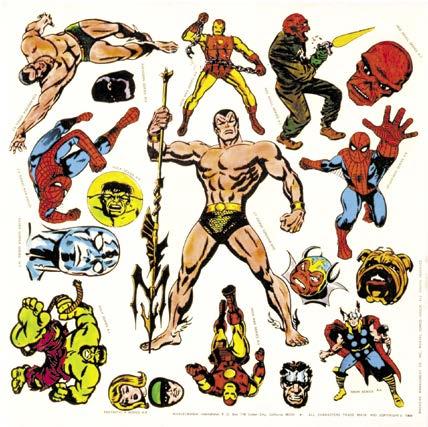

ing line in the late 1960s, placing more responsibilities upon the editorial offices, it no doubt made sense to broker Marvel merchandise sales and fan club activities through an outside third party. And thus came the Marvelmania announcement in 1969.
“I first found out about Marvelmania in The Amazing SpiderMan #78 (Nov. 1969),” comics historian Richard Kelsey tells BACK ISSUE . “ Spider-Man was my favorite comic at that time, and there was a half-page ad for Marvelmania in it and in every Marvel comic for that month. Those Marvelmania half-page ads regularly appeared in every Marvel comic every month from then on and until the club ended. The ad was usually on the same page as the Mighty Marvel Checklist. So, the ads were predominantly featured and always got my attention.”
According to Wikipedia, the original Marvelmania International membership kit cost $1.75 plus 25¢ postage and handling. Offered were a membership card, a Captain America poster, Marvel character decals, a 16-page catalog of Marvel products, a test edition of Marvelmania Magazine #1 (Oct. 1969), a Dr. Doom Mad Money coupon, and a Marvelmania flyer newsletter. After the initial text edition of Marvelmania Magazine , the publication continued with a new issue #1 (cover-dated Apr. 1970) and ran for six issues. More products were commissioned, primarily pinback buttons, posters, a stationery kit, and art portfolios. Jack Kirby and other Marvel artists were promised generous rates to produce original artwork for posters and products.
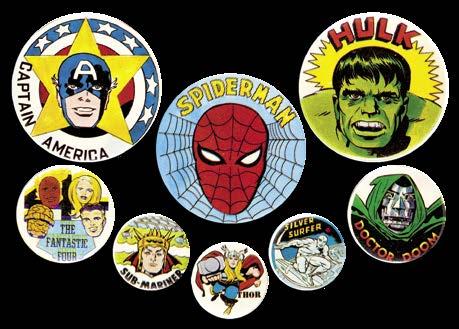
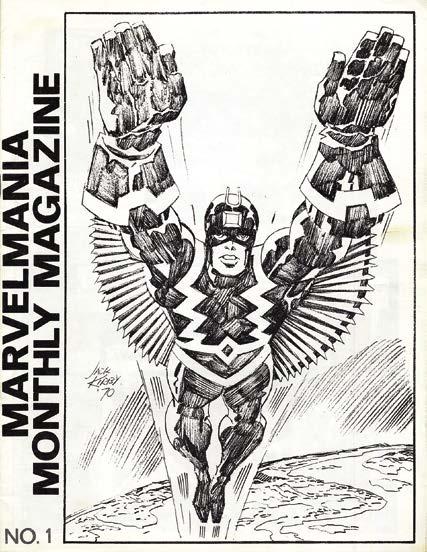
(left) Early Marvelmania merchandise included these colorful decal sheets. The stickers shown here were originally from the collection of Steve Sherman. (top right)
Jack “King” Kirby was hired by Marvelmania International to produce new art for merchandising, which included these character pinback buttons. (bottom right)
Kirby’s Black Bolt flies high on the cover of the first issue of Marvelmania Magazine (Apr. 1970).
TM & © Marvel. Marvelmania Issue • BACK ISSUE • 3

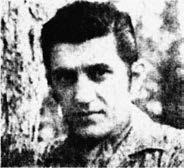
and and
Earth’s Mightiest Heroes Earth’s Mightiest Heroes
by Robert Menzies
Meet the New Avengers Artist
Sal Buscema’s stunning Avengers debut: issue #67 (Aug. 1969), featuring Ultron. Inks by Sam Grainger. Courtesy of Heritage. (inset above) The artist, as seen in the Bullpen photo gallery from Fantastic Four Annual #7 (Nov. 1969). Unless otherwise noted, images accompanying this article are courtesy of Robert Menzies.
TM & © Marvel. Marvelmania Issue • BACK ISSUE • 7
SAL BUSCEMA ‘AVENGERS’ CHECKLIST
Cover Art
Pencils: #67–72; Inks: #84, 191; Full art: #88–91 and Annual #4
Interior Art
Pencils/breakdowns: #68–72, 78, 86, 88–89, 92, 127–134, 156, 158–159, 169, 172–173, 193, 227; Inks: #87, 98; Full art: #90–91
Sal also drew new covers for 1972’s Marvel Triple Action #5, 6, and 8, which reprinted Avengers #10, 12, and 14, respectively.
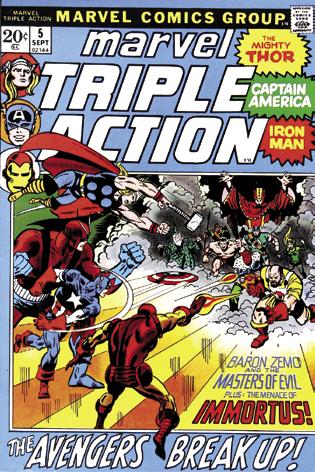
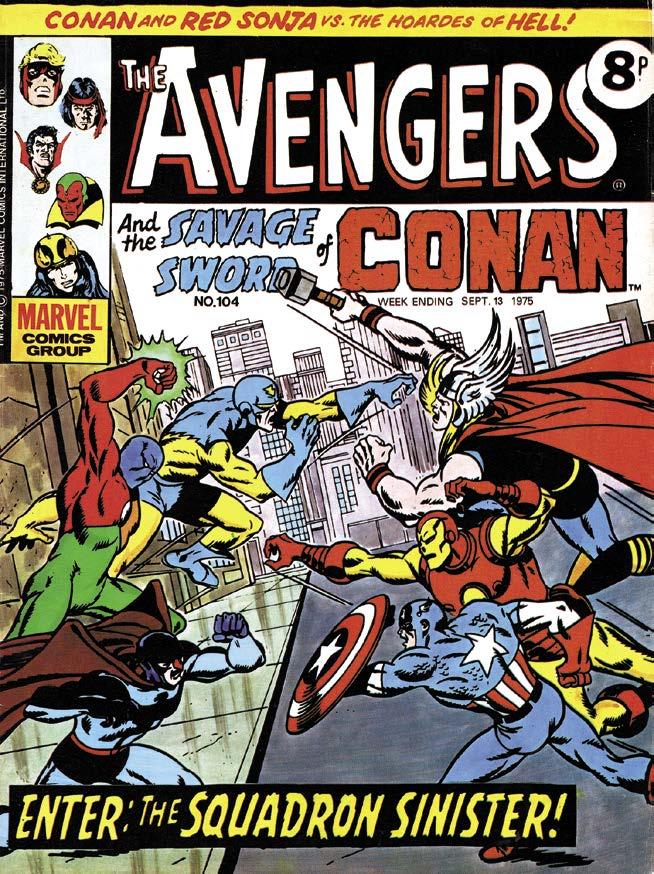
[
Author’s note: At the time of writing, Sal Buscema was unavailable for an interview for BACK ISSUE , and so I have relied on past interviewers, to whom I am enormously grateful. I hope, when he sees this, that Sal enjoys our collective stroll down memory lane (Memory Lane, in this instance, being located to the rear of Avengers Mansion, 809 5th Avenue, New York City, NY 10065).]
The interview to be artist on The Avengers was the best interview of Sal Buscema’s life—one to tell the kids, grandkids, and future, as-yet-unforeseen, interviewers about. Stan Lee, Marvel’s editor, head writer, and inexhaustible driving force, had been bowled over by Sal’s pencil samples and invited him to come up to Marvel’s Madison Avenue offices for a one-on-one meeting. Big brother John Buscema had known Stan since the late ’40s and filled in Sal, but he hadn’t been expecting to see Stan leap onto furniture like a five-year-old propelled by a sugar rush. After this frantic crash course in how to tell a story the Marvel Way, a dazzled Sal walked out with an assignment: he was now the pencil artist for Earth’s Mightiest Heroes.
British Variant 1
(left) The cover of The Avengers and the Savage Sword of Conan weekly #104 (Sept. 13, 1975), with character omissions, reproduces (right) Sal Buscema and Sam Grainger’s cover for The Avengers #70 (Nov. 1969).

8 • BACK ISSUE • Marvelmania Issue
TM & © Marvel.
TM & © Marvel.
Before the 1978 publication of the Marvel Novel Series, one could literally count the number of superhero comic book novels on the fingers of one hand: The Adventures of Superman by George Lowther (Random House, 1942); Batman vs. the Three Villains of Doom and Batman vs. the Fearsome Foursome (New American Library, 1966), both by Winston Lyon, the pseudonym of William Woolfolk; The Avengers Battle the Earth-Wrecker by Otto Binder (Bantam, 1967); and Captain America: The Great Gold Steal by Ted White (Bantam, 1968).
For most of the 1940s and through the 1960s, comic books were considered kids’ stuff. The eightto 13-year-old readership wasn’t any traditional book publisher’s idea of a profitable demographic, unlike the popular movie and television adaptations of the 1950s and 1960s. The novel The Adventures of Superman in 1942 was an anomaly, taking advantage of the Man of Steel’s popularity at the nexus of comic books, animated cartoons/radio program/ newspaper strip, and licensing that no comic book character would match until Batman exploded onto television in 1966.
And though Batman may have instigated the 1960s comic book paperback book publishing miniboom (NAL also released three paperback black-andwhite cut-and-paste reprints of Golden Age Batman comic book stories under its Signet Books imprint: Batman , Batman vs. the Joker , and Batman vs. the Penguin, as well as one volume of Superman stories... and Bill Adler’s Funniest Fan Letters to Batman), it was Marvel that had the decade’s last word with Bantam Books’ Avengers and Captain America novels in 1968 (along with six back-and-white comic book reprint paperbacks, one each of Spider-Man, the Hulk, Daredevil, and Thor, and two of the Fantastic Four).
It was a short, intense burst of welcome activity for comics fans on the paperback spinner racks, almost two dozen titles (including Belmont’s reprint of MLJ’s High Camp Super-Heroes and Tower’s four T.H.U.N.D.E.R. Agents reprints in 1966) over the course of a few years.
But the fad was short-lived. The last episode of television’s Batman ran in March of 1968 and the entertainment tide turned away from the four-color world to other genres. It would be another decade before superhero stories were again told in words, without pictures.
Web-Slinging Novel Citizen
Your friendly neighborhood you-know-who versus the Kingpin on Bob Larkin’s painted cover for Paul Kupperberg’s Marvel Novel Series #8: The Amazing Spider-Man: Crime Campaign. All images accompanying this article are courtesy of Paul Kupperberg.
by Paul Kupperberg
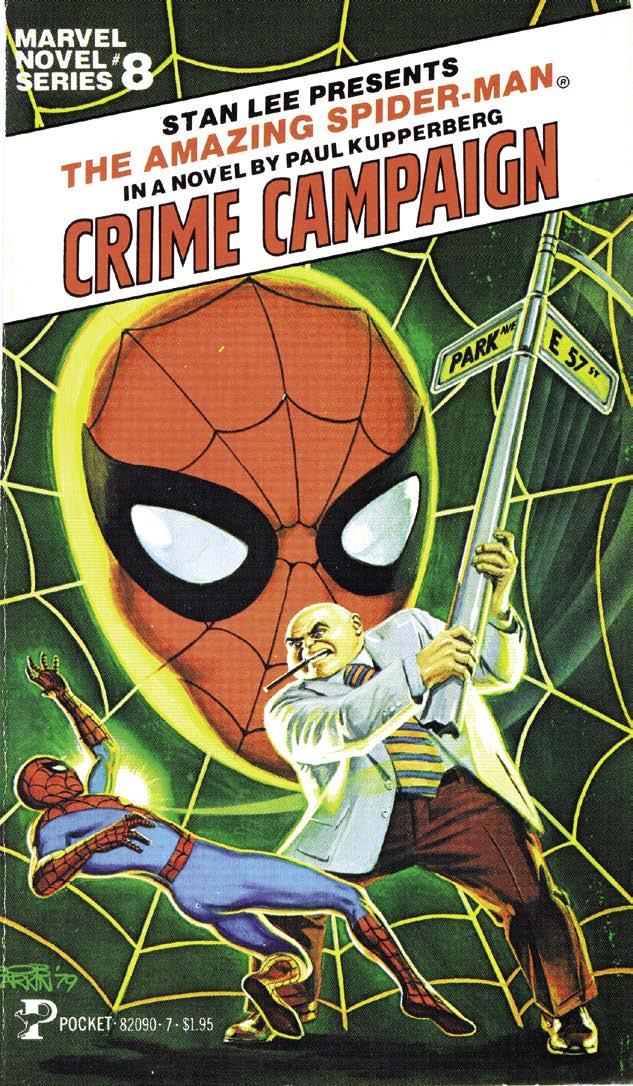
TM & © Marvel. 18 • BACK ISSUE • Marvelmania Issue
But I was at least a known quantity and had, in fact, been at many of the same poker tables Wolfman and Wein shared with Paul Levitz. Even if they had never read any of my published work, I apparently fell into the “heard something in conversation” category. In the 1980s when we briefly shared an editorial office at DC Comics, I asked Wein why I had been asked to write Spider-Man in particular. Len said, “Have you ever heard you speak? You’re a bigger wiseass than Peter Parker.”
Marvel Novel Series #10: The Avengers: The Man Who Stole Tomorrow author David Michelinie had a similar experience. Starting at DC, where he co-created Claw the Unconquered, Star Hunters, and Gravedigger, as well as writing Swamp Thing and Aquaman, the Kentucky native moved over to Marvel in the late 1970s, where he enjoyed long runs on Amazing SpiderMan, Iron Man, and The Avengers
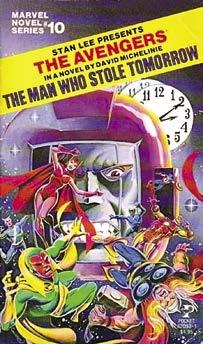
“I’m pretty sure The Man Who Stole Tomorrow was my first published prose fiction,” according to Michelinie. “If you don’t count the Sherlock Holmes parodies a friend and I wrote and sold at school for a nickel apiece when I was ten years old. Until a teacher found out and chucked our inventory into the nearest trash can.”
Michelinie recalls, “I was indeed contacted by Len/Marv to write the book, but I don’t remember which one... [and] I don’t know if my being the writer on The Avengers comics series had anything to do with me being offered the assignment, but I assume there’s a strong possibility that it did.” He added, “My original title was The Tomorrow Thief. The editors changed it to The Man Who Stole Tomorrow which, I grudgingly admit, was better.”
According to Wolfman, “I believe a couple of writers used pseudonyms because they had other contracts or because they had to write so fast, they didn’t want the work held against them. I actually think all the books were fine, and some were really excellent.” One of those multi-book authors was the prolific Ron Goulart (January 13, 1933–January 14, 2022), who worked on two books as “Joseph Silver.” The other was DC writer Martin Pasko (August 4, 1954–May 10, 2020), whose Daredevil story “Blind Justice” in The Marvel Superheroes anthology appeared under the name “Kyle Christopher.”
ENDING WITH A WHIMPER
I was assigned two books in the series, #8: The Amazing Spider-Man: Crime Campaign and #11: The Hulk and Spider-Man: Murdermoon . I signed the contracts for the pair on October 6, 1978. They were due by December 15, 1978. In between, I uprooted my life and relocated from Brooklyn to Chicago, but the deadlines were somehow met, and the books were released, the former in July 1979 and the latter in October.
There weren’t many models for writing superheroes in prose. Were they supposed to read like Lowther’s juvenile The Adventures of Superman, or the tonguein-cheek approach of Lyon/Woolfolk’s Batman books and Binder’s Avengers ? Who was the audience? Largely readers of the comics, I assumed, but there was a strong possibility someone without deep
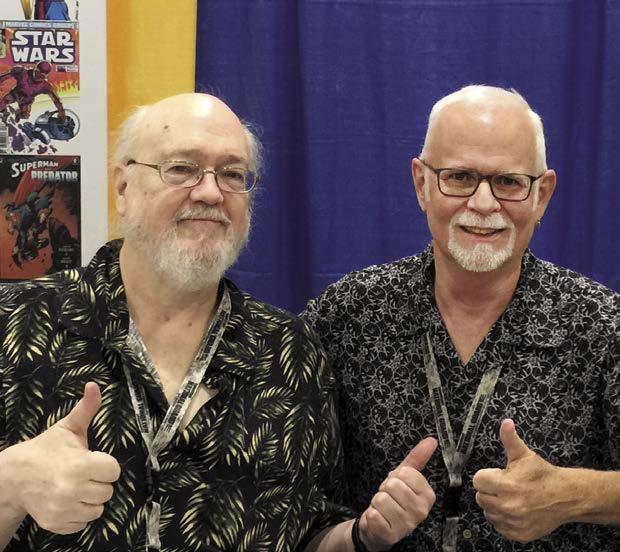
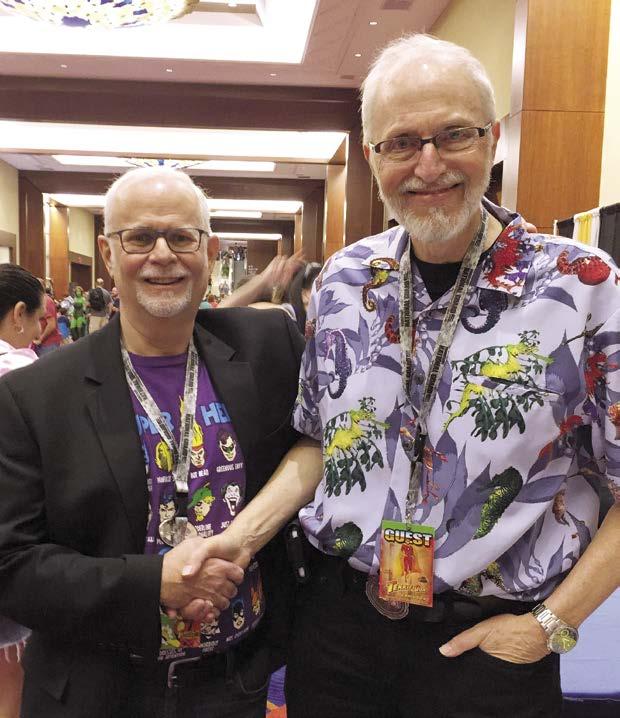
When Authors Collide
(top) Marvel Novel Series authors David Michelinie and Paul Kupperberg in 2018. (bottom) Kupps shakes hands with Marv Wolfman at a 2017 convention.
Marvelmania Issue • BACK ISSUE • 21
by Ed Lute
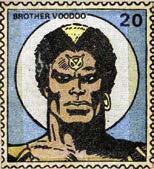

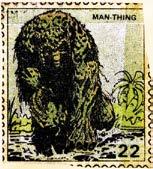

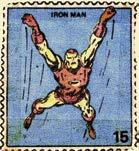
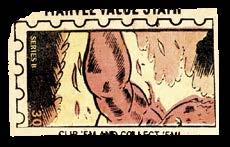

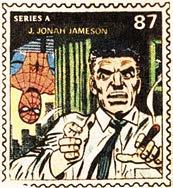
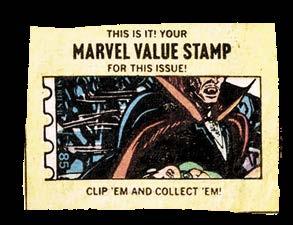
What comic book–loving fan doesn’t enjoy cutting up their comic books on a regular basis? No one, of course! Well, except back in the mid-1970s, when Marvel Comics gave readers a reason to take their scissors to their four-color pages with its Marvel Value Stamps (MVS).
Come along as BACK ISSUE clips out the history of the MVS promotion and its legacy.
SERIES A
On the Bullpen Bulletins page for Marvel comics cover-dated February 1974, an image of the Incredible Hulk with an orange background appeared. Stan Lee asked fans to guess what the secret of the image was. The following month Stan revealed that the image was a stamp, but “not just any run-of-the-mill, lick-it-and-stick-it-on-apostcard stamp, but the fabulous forerunner of a whole herd of—are you ready for this?—MARVEL VALUE STAMPS.”
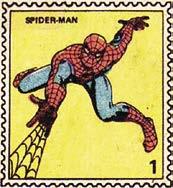


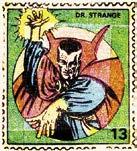

However, it wasn’t until the April 1974 cover-dated issues that Stan gave fans the whole story. There would be 100 numbered stamps featuring images of the heroes, villains, and supporting characters of the Marvel Universe, as well as some licensed properties like Conan. The stamps would appear across all of Marvel’s comic book line except for reprint titles. This gimmick inspired readers to search out books that they might not be regular readers of. The hope was that not only would there be an immediate sales increase for the entire line, but that fans would become regular readers of a newly discovered title.

According to Roy Thomas in his introduction to the book Marvel Value Stamps: A Visual History , from Abrams ComicArts, “Stan and I were painfully aware that—shocking as it might’ve been to us—not every Marvel fan bought every Marvel comic book title. Some might purchase The Amazing Spider-Man but not Fantastic Four, or even Marvel Team-Up (in which
You Can’t Lick Marvel’s Mightiest!
In the mid-1970s, fans took scissors (>gasp!<) to their beloved Marvel comics—under the direction of Stan and Roy!—clipping Marvel Value Stamps from letters pages and inserting them into this specialty stampbook. Courtesy of Heritage Auctions (www.ha.com).
TM & © Marvel. Conan © Conan Properties International, LLC. Marvelmania Issue • BACK ISSUE • 23
ROY THOMAS IMDb.com.
by Douglas R. Kelly
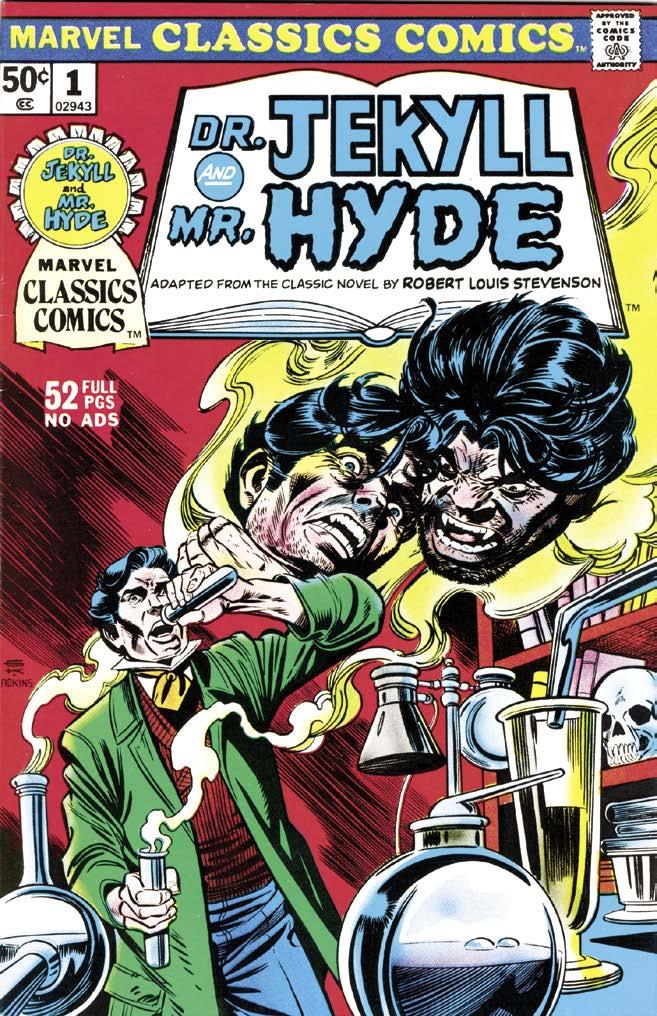
A little more than a year ago, one of my closest friends died suddenly. While I tried to get my head around Andy not being here anymore, his sister asked me to speak at his memorial service. She also lined up two more members of our posse, one of whom asked me what I thought I would say. I told him that I didn’t know, that I couldn’t imagine what I could say that would sum up Andy’s life and our 45 years of being the best of pals. My friend said to me, “You can’t sum up Andy’s life in eight minutes, nobody could do that for another person. What each of us can do is try to share who we think he was… sort of like, who was the essential Andy?”
This rattled around in my head for a while, and finally I just thought, “All I can do is share what Andy meant to me, and if the other guys do that too, maybe we’ll get to, more or less, the essence of our great friend.” To my surprise, that was pretty much what happened—the three of us came at the subject from different places, and I think we managed to convey what we thought made Andy, Andy.
Adapting the work of a great artist into another medium, it seems to me, likely follows a similar path. Imagine trying to sift through a 400- or 500page literary epic, looking for what makes that story unique, looking for the essence of that great novel. Then imagine that you have to squeeze it all into a 48-page comic book.
It had been done before, of course. The Gilberton Company introduced its Classic Comics series in 1941, offering readers of the time access to classic works of literature. The name eventually was changed to Classics Illustrated , and over the
Bottoms Up!
Gil Kane and Dan Adkins delivered this shocking cover for the first issue of Marvel Classics Comics (1976), adapting Robert Louis Stevenson’s 1886 novella, The Strange Case of Dr. Jekyll and Mr. Hyde. Unless otherwise noted, scans illustrating this article are courtesy of Douglas R. Kelly.
TM & © Marvel. Marvelmania Issue • BACK ISSUE • 31
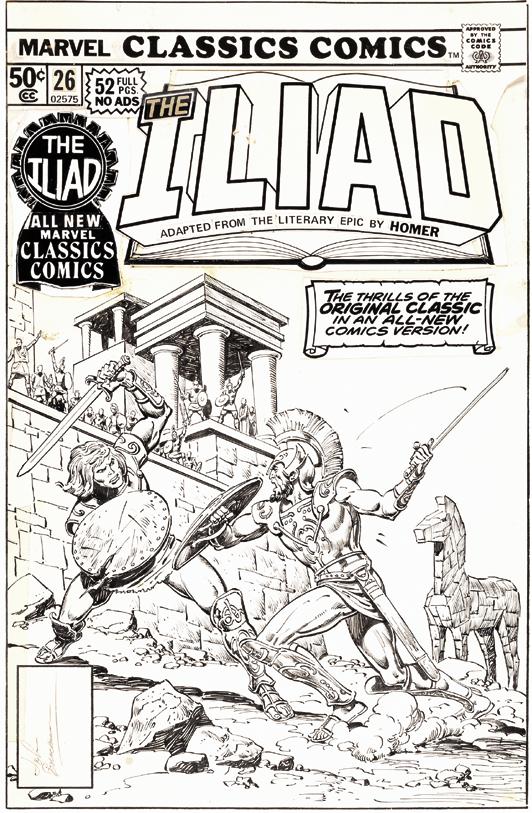
Another
‘Hit’ from Homer (left) D’oh! Swordplay at its most dazzling, as rendered by penciler
John Buscema and inker Ernie Chan for Marvel Classics Comics #26 (1977), adapting The Iliad. Autographed by Buscema. (right) A gorgeous interior page from The Iliad, showcasing the art of Yong Montaño. Both, courtesy of Heritage.
TM & © Marvel.
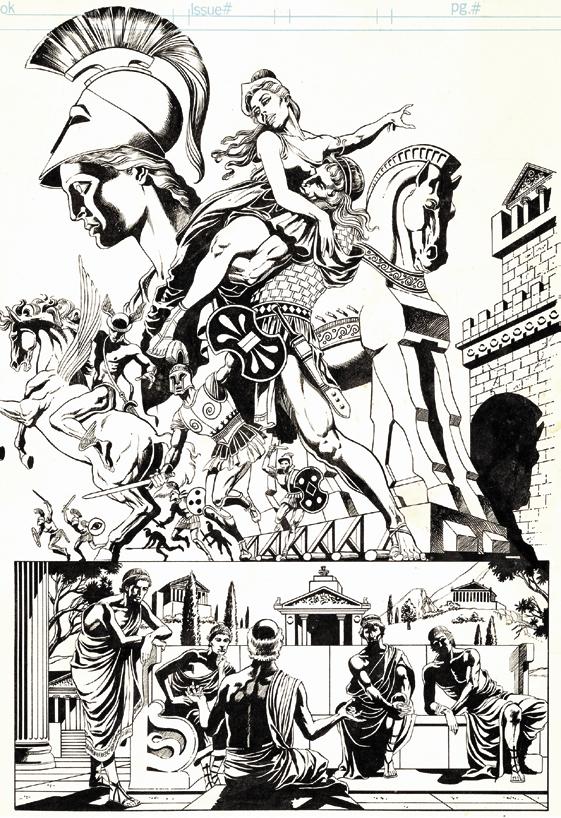
issue #13, several new names were added to the masthead along with writers and artists. One was the new editor of the books going forward, John Warner. Another, listed under “Production & Staff,” was Ralph Macchio. “I worked closely with John,” says Macchio. “In 1976, Archie Goodwin became editor-in-chief at Marvel. Archie had been the editor on the black and white line, a job that now was vacant, so John Warner became editor on that line. I was hired as John’s assistant, so I worked with him on the black and white magazines, along with the Marvel Classics Comics series.
“I was 24 when I came to Marvel. I had done my undergraduate work at Fairleigh Dickinson University, then went for my graduate work at Montclair State. I was intending to go into teaching, probably to be a high school English teacher. But teaching jobs were scarce at the time. When I got the opportunity to work at Marvel, I took that and I thought I’d be able to finish my studies but I wound up staying at Marvel. So I have a background in English lit, and that served me well when I was hired at Marvel because I had an understanding of grammar, and that was something that came in handy for proofreading and so on. I think that’s why I was given the opportunity to work on [this series].”
For that issue #13, Doug Moench wrote/ adapted James Fenimore Cooper’s The Last of the Mohicans , which was a natural match for the writer—but he had his own ideas about how the story wound up. “My most beloved Classics Illustrated comic was The Last of the Mohicans . Now, it’s great, but the original wasn’t that well written, it’s kind of turgid. So I went back with that one and I couldn’t read it all, so I skimmed it and got the important parts… and then I re-wrote the ending [for the Marvel Classics Comics version]. And I still think that it’s better than the original ending, because my re-written ending is all about the title… it’s about the fact that he is the last of the Mohicans. The original novel totally dropped the ball on that… I remember thinking, ‘Didn’t you know what you had in your title here? They’re going extinct, he’s the last one!’”
Gil Kane drew the cover, and with Marvel-style lettering complimenting Sonny Trinidad’s interior art, this was the first of the Classics series to fully look the part of a Marvel comic.
Issue #14 featured the legendary H. G. Wells novel, The War of the Worlds . Chris Claremont, who declined being interviewed for this article, wrote and adapted the story, and he stayed pretty true to Wells’ narrative as we see the main character’s sense of despair of humankind
38 • BACK ISSUE • Marvelmania Issue
An exploration of
 by Ian Millsted TM
by Ian Millsted TM

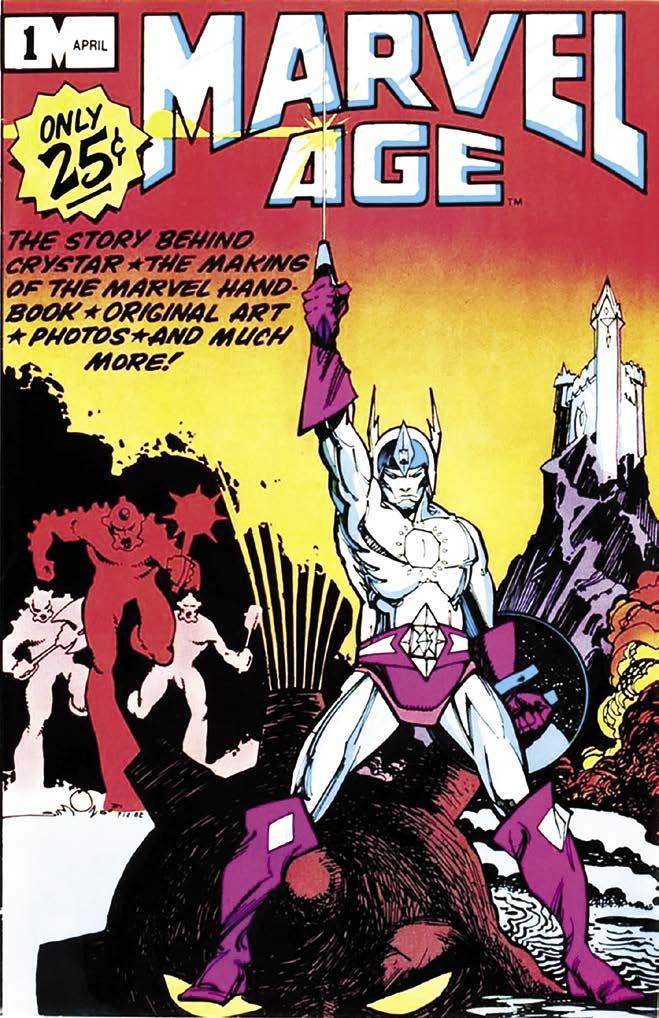
The mid-1980s was a time of evolution and development in the comics industry, seeing the rise of the direct market, popular miniseries and maxiseries, company-wide crossovers, imprints for creator-owned titles, collected editions and graphic albums (for the bookstores), and much more.
One magazine that was perfectly positioned to chronicle Marvel Comics’ contribution to all of the above was Marvel Age , which launched a first issue cover-dated April 1983. The first thing most potential readers would have seen was the cover by Walter Simonson (promoting his new Crystar series), which is a pretty nifty place to launch from. Although the magazine was listed as just Marvel Age in the indicia, it was usually referred to as Marvel Age Magazine by those who worked on it. The addition of the “zine” word is significant. This was a place where there would be information for the fans and retailers.
Marvel Age was initially a 20-page magazine, in comic book size and format, with early issues edited by Carol Kalish and others (including Peter David). It was mainly a listings and promotion magazine, retailing at 25 cents, at a time when a standard Marvel comic cost 60 cents.
Jim Salicrup shares his insights with BACK ISSUE: “ Marvel Age was originated by Marvel’s Sales Department, but since it was also printed comic book size, Jim Shooter had to approve it. I proposed to Jim that I go over it and make notes for him, since he was a super-busy guy, and much to my surprise he made me the editor of Marvel Age.” The page count was soon increased to 36 pages, which allowed Salicrup and his team to further develop the title.
FOOM Has Left the Room
The debut edition of Mighty Marvel’s Big ’80s self-promotional series, Marvel Age. Issue #1’s (Apr. 1983) cover by Walter Simonson heralded Marvel’s new Crystar series (which we’ve yet to explore here in BI—anyone want a Crystar article in a future ish? - ed.). TM
& © Marvel. Marvelmania Issue • BACK ISSUE • 43
Voodoo You Think You Are?
Brother Voodoo and Doc Samson drop in on Fred Hembeck in the “Hembeck’s Page” (a doublepage spread) from Marvel Age #20 (Nov. 1984).
which really wasn’t enough to cover expenses living in the New York City area, so rather than hustle until I found more work, I moved back to the Boston suburbs and then to upstate New York, where I’d gone to college, and I could get by on less. But then, when I was fired from Power Man and Iron Fist, I suddenly had no income, and I hadn’t built up any relationships with editors because I wasn’t able to come in to the offices.
“So I came back down to the New York City area, stayed on a friend’s couch for a few weeks, and dug up some work. I did the Red Tornado miniseries and a couple of fill-ins for DC, which earned me enough money to move down to a New Jersey apartment. At Marvel, I did a couple of Power Man and Iron Fist fill-ins—ironically, the guy who replaced me was slow enough that they needed some help—and Jim Salicrup told me he didn’t have any comics for me to write, but his assistant on Marvel Age was leaving, and he could use a new one. So I took that gig, and did my best with it for a while.” One of Busiek’s contributions was wrangling together a 20-page “A Day in the Life of Marvel Comics” for issue #35 (Feb. 1986). The article is a useful document for future comics historians.

“I’m almost positive that was Jim’s idea, but I have very few actual memories of it,” Busiek says. “I don’t think I wrote the article solo, though. As I recall, we had various ‘reporters’ shadow the various editors for a day, taking note of what they did—I think I shadowed Don Daley?— once they were done everyone wrote up reports on what went on in that editor’s office for the day, and they turned them in to me. And I collated them and did kind of a style-edit on it all so it read smoothly rather than like a bunch of different voices.”
Another frequent contributor was Dwight Jon Zimmerman, who shares his memories with BACK ISSUE. “I first met Jim through friend David Kraft, who was my high school best friend, in the mid-’70s. We got to know each other and, following a four-year detour to Rabun County, Georgia, where David wound up living, upon my return to New York City, I renewed my friendship with Jim. One of our off-duty routines was a Sunday visit to comic book shops to gossip, check out what other publishers were doing. We’d visit the used bookstore Strand Books.”
Despite being a house magazine for a commercial publisher, Jim Salicrup and his colleagues were

46 • BACK ISSUE • Marvelmania Issue
© Fred Hembeck. © Marvel.
dwight jon zimmerman
by Robert Menzies
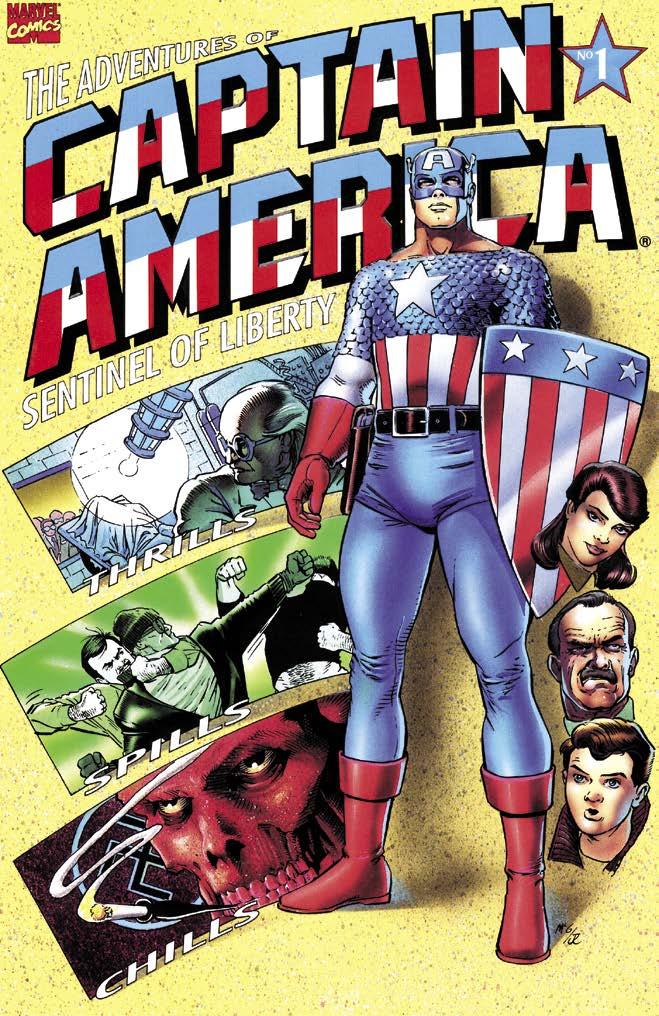
There’s something almost mythical about the great superhero origin stories. Created in 1940 by Joe Simon and Jack Kirby, Captain America was probably inspired as much by revulsion for Nazism as he was by potential sales figures. While the familiar core elements never alter—during World War II, sickly volunteer Steven Rogers is declared medically unfit to serve in the armed forces, but is later transformed by a secret government experiment into the world’s first Super-Soldier—in all other ways the origin story is not nearly as consistent as readers believe or remember. With almost each retelling, Cap’s origin has been tweaked and expanded, sometimes contradicting previous accounts in significant ways.
Most versions of the origin run to only three or four pages, with none longer than a standard-length comic. However, by far the most forensic examination of the process through which Steve Rogers became Captain America is the early 1990s limited series Adventures of Captain America ( AOCA ). Written by Fabian Nicieza, with pencil art by Kevin Maguire, Kevin West, and Steve Carr, and inks by Joe Rubinstein and Terry Austin, this was an ambitious project of four 48-page issues. Rogers’ training process had received scant attention in previous stories. The selection process, even less. This series was going to address those “gaps,” as well as contend with inconsistencies and the character’s long history.
As the back-cover blurb to AOCA #1 announces:
For the first time, complete and unexpurgated, with many never-before-revealed details, it’s the origin of the greatest hero of World War II -- Captain America!”
Surprisingly little analysis of this groundbreaking series has been done. In a riveting face-to-face interview with me at Edinburgh Comic Con on April 15, 2018, Fabian Nicieza revealed the behind-the-scenes events that led to the series, why he thought for so long his series was a failed experiment, and why he now sees it differently. He also explained why he and Maguire felt a sense of injustice after Captain America: The First Avenger was released in 2011.
– Robert Menzies
ROBERT MENZIES: Thanks for agreeing to speak to BACK ISSUE about your series, Adventures of Captain America, Fabian. I first wanted to ask if you remember your first Captain America story and what your early impressions of the character were.
FABIAN NICIEZA: I have to be honest, I don’t remember the first Cap issue I read because we first started to get comic books in late ’66, early ’67. We had just come to the United States from Argentina and I was just learning how to read and speak English. My brother, who was three years older, was the one who was really driving the buying and I just ended up looking at whatever
Thrills, Spills, and Chills!
Cover to The Adventures of Captain America #1 (Sept. 1991). Art by Kevin Maguire and Joe Rubinstein.
TM & © Marvel.
Marvelmania Issue • BACK ISSUE • 51

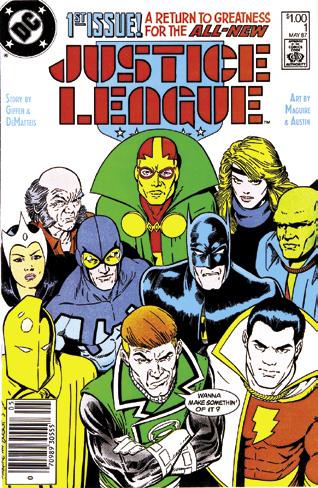
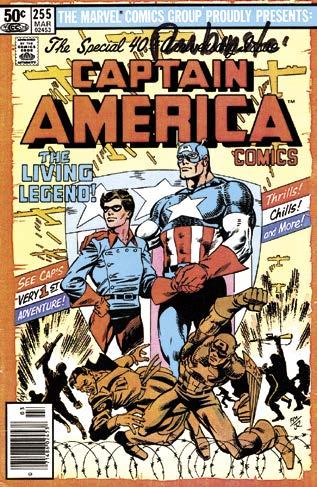
Make Mine Maguire!
(top) Fabian Nicieza, the author of The Adventures of Captain America, proudly displays a copy of issue #1. Photo by Robert Menzies, taken on Sunday, April 15, 2018 at the Edinburgh Comic Con. (bottom left) The Adventures of Captain America largely came about because Marvel editor-in-chief Tom DeFalco wanted one-time Bullpen artist Kevin Maguire back after Kevin helped make a hit of competitor DC’s Justice League #1 (May 1987). (bottom right) Prior to the Nicieza/Maguire miniseries, Captain America #255’s (Mar. 1981) retelling of Cap’s origin lingered in many fans’ minds.
Cover by John Byrne and Joe Rubinstein, signed by Rubinstein. From the collection of Robert Menzies.
he got. The first time I really started to understand what I was reading was late ’67, I was in first grade and my memories really kick in around that time. We were only allowed to get one or two books a month because they were expensive, 12 cents a book! [laughs]
I think the first time I saw Captain America was in a Tales of Suspense issue. I remember mid- to late 1968, Captain America was an Avenger, so I was reading Captain America in The Avengers. I decided I was going to get Avengers every month because for 12 cents I could get lots of heroes instead of just one or two. That was when I started to get The Avengers, in the issue #80s. I continued buying The Avengers every month, all through to my job at Marvel in ’85, and then I got them for free. So, I became most familiar with Cap through the Avengers, but then I went back and anywhere that a Cap reprint appeared I would end up buying it.
MENZIES: Was he a hero you always liked?
NICIEZA: Yeah, yeah. He was always considered straight-laced and boring, but what I would do is that I would pick up short bursts if something sounded interesting that was going on. I know I got a huge chunk of the Englehart/Buscema run, all the “Secret Empire” stuff, Falcon getting his new wings, I remember distinctly buying that because of the cover. [Interviewer’s note: The Black Panther gifted Falcon his new wings in Captain America #170 (Feb. 1974); the artwork that Nicieza is remembering is John Romita’s classic cover to #171.] I still think it’s one of the best covers ever. I bought the whole “Secret Empire” run [#169–176, Jan.–Aug. 1974] because it was a really interesting story and Englehart was putting Cap through his paces, so I got the whole Nomad arc afterwards. I bought Cap for about a year and a half, up to the point where Frank Robbins took over as artist and that didn’t interest me [#182, Feb. 1975].
I started picking up Cap again when Kirby came back [#193, Jan. 1976]. So, I bought the whole Kirby run while it was coming out. And then I didn’t pay attention to Cap as a monthly book until John Byrne and Roger Stern got on the book [#247, July 1980], and I started buying Cap again. A little later I saw the Deathlok cover that Zeck did [probably issue #286, Oct. 1983], and the Deathlok story, and I liked a lot of what DeMatteis was doing so I would check that out. So I would always jump back in in bursts, it was never a monthly purchase, but if you look at my original collection from the ’60s, ’70s, ’80s, or whatever, I’ve got a lot of Cap in there. But it wasn’t necessarily my love of Cap that had me working on the project.
MENZIES: So, what brought you to writing Adventures of Captain America?
NICIEZA: The genesis of me working on the project was pretty simple. [Marvel’s then-editor-in-chief] Tom DeFalco wanted Kevin Maguire back. Kevin was ours, and we lost him. [ laughs ] Kevin was a Romita Raider—he worked on staff for just a short amount of time as one of the Romita Raiders, an art-correction guy. His talent was obvious to everyone—his ability to maintain a monthly schedule was questionable to everyone, including Kevin. [ laughs ]
& ©
52 • BACK ISSUE • Marvelmania Issue
TM
Marvel.
by Dan Tandarich

Movie producer Michael Uslan may be known as The Boy Who Loved Batman , but he also loves superheroes, including Marvel’s vast gallery of crimefighters and world-savers, as well as history, movies, and New Jersey.
Uslan pitched three Marvel potential storylines in the 2000s. He thought big… and what could be bigger than Marvel’s own version of DC’s epic Crisis on Infinite Earths, starring the Cosmic Cube? The Cube played into Uslan’s envisioned action epic featuring a WWII adventure melding history and superheroes. And, coming full circle in this Marvel triple feature, we end with an idea introducing a Marvel version of DC Comics’ Earth-Two with Golden Age incarnations of Marvel’s Silver Age heroes.

So, what if Michael Uslan had paused his movie producer occupation and authored stories for Marvel? Well, wonder no more, as “The Greatest Stories Never Told” reveals more of Michael Uslan’s takes on the Marvel Universe! But fair warning, when one reads a Michael Uslan story, they better be prepared to research history, watch a few movies for references, and a trip to New Jersey wouldn’t hurt either.
In his 2022 book Batman’s Batman , Uslan shared, “Long before anyone thought to make an Avengers movie, I wanted to write a miniseries called The Cosmic Cube … I was told that it tied into too many characters whose storylines were already set for the next year or two.” But had this story been published, it would have had major ramifications.
Uslan reveals to BACK ISSUE, “This was to be the Marvel Comics version of DC’s Crisis [on Infinite Earths]. And I already knew there were A-list artists who wanted to bring these tales to life.”
The Cosmic Cube can do virtually anything. It is the ultimate power! And everything you think you know about it is untrue! Uslan’s plot reads, “But it has its own supreme intelligent design that… never would have allowed any of its real secrets and
‘He Who Holds the Cosmic Cube’… …wields unfathomable power, as shown by Jack Kirby (inked by Don Heck) on this augmented detail from the cover art from Tales of Suspense #80 (Aug. 1966). Decades after the King of Comics drew this dynamite cover, Michael Uslan imagined a new opus involving the Cube whose effects would ripple throughout the Marvel Universe.
Marvelmania Issue • BACK ISSUE • 63
TM & © Marvel.
michael uslan
‘A Time of Marvels’
Jim Hammond, the original Human Torch, whips up quite a stir among the folks on the street on Alex Ross’ cover artwork for Marvels #1 (Jan. 1991). All art scans accompanying this interview are courtesy of Alex Ross.



In 1994, a new four-issue miniseries debuted. It was titled Marvels, and it burst upon the scene with the force of Mjollnir.
That massive impact has been felt ever since, and on this, the 30-year milestone since its release,
by Bryan D. Stroud
writer Kurt Busiek and artist Alex Ross answer a few questions for BACK ISSUE about this truly groundbreaking blockbuster that continues to make waves in the industry.
– Bryan D. Stroud
68 • BACK ISSUE • Marvelmania Issue
TM & © Marvel.
ALEX ROSS Facebook.
KURT BUSIEK

BRYAN D STROUD: Can you describe the research process for Marvels? KURT BUSIEK: We had pitched several different iterations before [then-Marvel editorin-chief] Tom DeFalco said that if you’re going to be exploring Marvel history, use the real Marvel history.
We had to research it in a different way. The first issue was all Golden Age material and I’d read very little of that. I bought a microfiche reader and I bought or borrowed certain Golden Age issues on microfiche and researched that way.
That was a lot of work, but at least I was only covering from 1939 through 1941. Then from Marvels #2 (Feb. 1994) and on, I had to know what was happening all over the various Marvel comics. We wanted to be able to say, “And this is where the Avengers are and this is what Spider-Man is doing.” So I had to have this collated by date rather than by series. We also needed to know what stuff was publicly visible.
I would go through all the Marvel comics and read them. I had printed out data sheets with the issue number and the title and date and “Here’s roughly what happens,” “Here is what would be seen in public,” and “Here are any media references.” I had a big, looseleaf notebook of Marvel continuity I could refer to.
That was time consuming, and it got more so because when I was researching for Marvels #2 (Feb. 1994), it was a period where Marvel could only publish limited monthly books, so some are bimonthly. By the time we get to #4 (Apr. 1994), which is taking place around 1972, Marvel’s line is much, much bigger.
Alex also had to do research, because every time I would specify something, he had to look that up. And there was stuff that he was interested in that he wanted me to put into the stories and I did that as best I could.
STROUD: The interconnectedness of the Marvel Universe had to be critical.
BUSIEK: If they hadn’t done that, we wouldn’t have had any story to tell. The fact that there is a Marvel Universe is why it was worth looking at from the point of view of the man on the street.
IF YOU ENJOYED THIS PREVIEW, CLICK THE LINK TO ORDER THIS ISSUE IN PRINT OR DIGITAL FORMAT!
There are different levels to this. Going back to the Golden Age, there were a couple of crossovers between the Human Torch and Namor, and later Captain America showed up in other series, and eventually, they teamed them up as the All-Winners Squad. In the early ’60s Marvel Universe, you’d have things like the Hulk meeting the Fantastic Four. But things don’t start to get seriously tied together until Roy Thomas wrote the Kree-Skrull War with Neal Adams and the Buscema brothers, because that’s the story where not only does it take place in Avengers, but there’s a crossover with an Inhumans story using Fantastic Four villains. Today it’s all on one stage.
ALEX ROSS: I would argue that the big battle that built up between the Hulk and the Thing in 1964 was the real beginning of that sense of everything overlapping in a shared mythology.
STROUD: Were you working full script or spending a lot of time on the phone or both?
BUSIEK: Marvels was created out of different threads of inspiration, but it started with Alex. Before Alex broke in as a comics artist, he had this idea to do a series
Man on the Street
Marvels POV shared with readers the spectacle of the burgeoning Marvel Universe, with character Phil Sheldon being our guide.
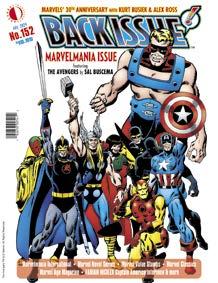
TM & © Marvel.
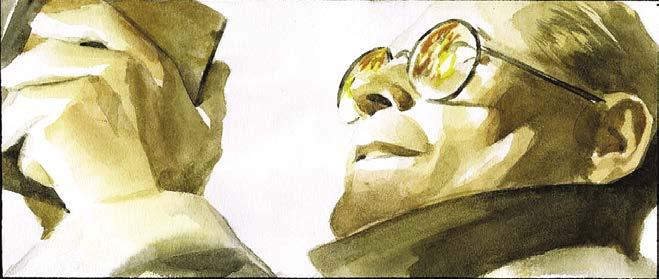

Marvelmania Issue • BACK ISSUE • 69
MARVELMANIA ISSUE! SAL BUSCEMA’s Avengers, FABIAN NICIEZA’s Captain America, and KURT BUSIEK and ALEX ROSS’s Marvels turns 30! Plus: Marvelmania International, Marvel Age, Marvel Classics, PAUL KUPPERBERG’s Marvel Novels, and Marvel Value Stamps. Featuring JACK KIRBY, KEVIN MAGUIRE, ROY THOMAS, and more! SAL BUSCEMA
FULL-COLOR magazine) $10.95 (Digital Edition) $4.99 https://twomorrows.com/index.php?main_page=product_info&cPath=98_54&products_id=1786
BACK ISSUE #152
cover. (84-page










































 by Ian Millsted TM
by Ian Millsted TM
















